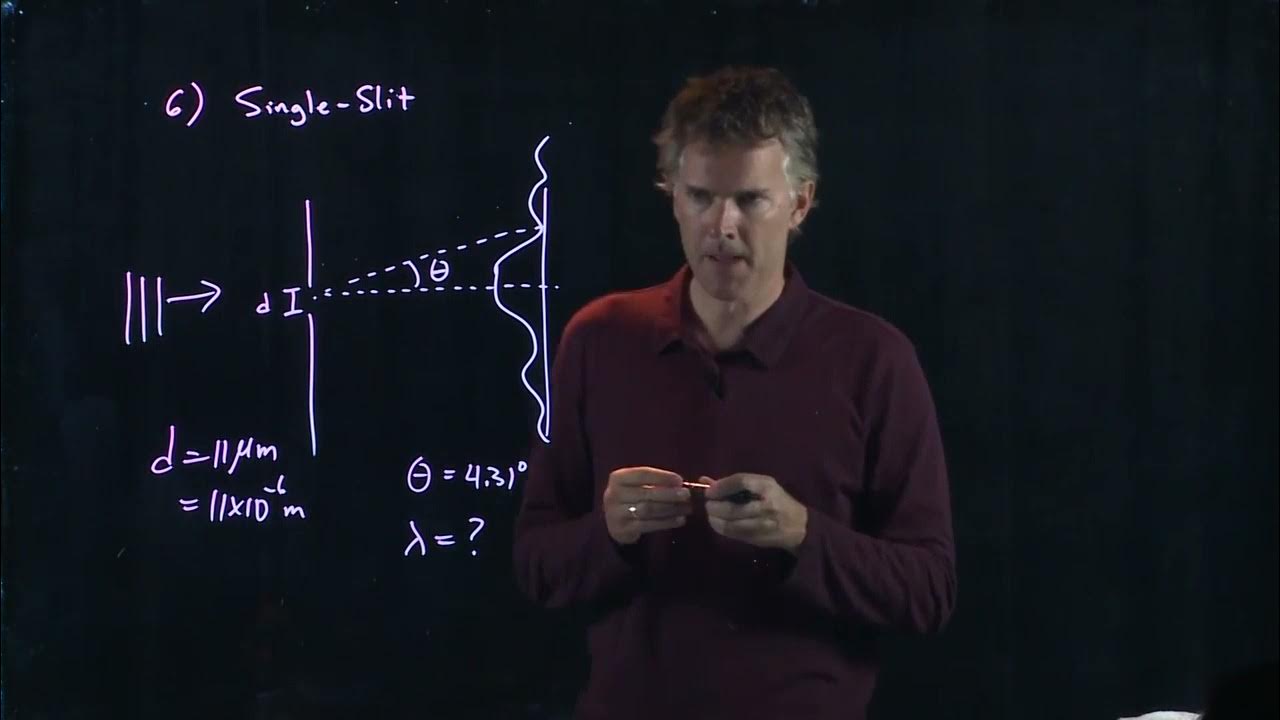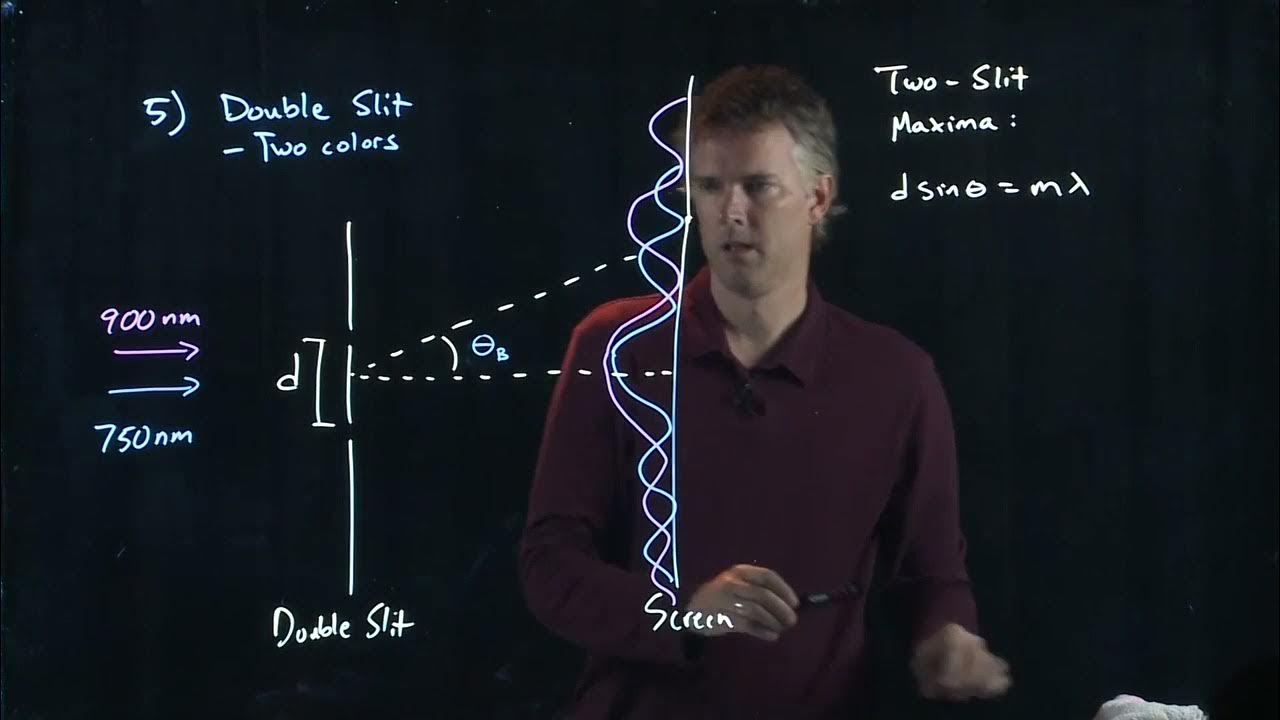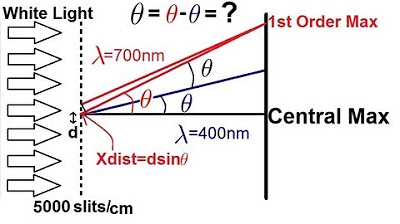Resolving Power of a Telescope | Physics with Professor Matt Anderson | M28-14
TLDRThe script explores the resolving power of a telescope to observe a hypothetical planet orbiting the nearest neighboring star, four light years away from the Sun. It explains the concept of diffraction and the minimum resolvable angle formula, θ = 1.22λ/d, where θ is the angle, λ is the wavelength (650 nm), and d is the telescope's aperture diameter. Using the Earth-Sun distance and the star-planet system's separation, the script calculates the required telescope aperture to resolve the system, concluding that a surprisingly small 20-centimeter diameter would suffice for such a distant observation.
Takeaways
- 🌌 The nearest neighboring star to the Sun is about four light years away, and if a planet orbits this star at an Earth-like distance, it poses a challenge for Earth-based telescopes to resolve.
- 🔭 The resolving power of a telescope is crucial for distinguishing between two closely spaced light sources, such as a star and a planet in this scenario.
- 🎨 The script uses a visual approach to explain the concept of diffraction and how it affects the image resolution of a telescope.
- 📏 The minimum resolvable angle, θ, is given by the formula θ = 1.22 * (λ / d), where λ is the wavelength of light and d is the diameter of the telescope's aperture.
- 🌟 The wavelength λ is provided as 650 nanometers for the light emitted by the star and planet.
- 📏 The Earth-Sun distance is given as a reference to calculate the distance h between the two light-emitting objects in the star-planet system.
- 📐 The small angle approximation is used to simplify the calculation of the angle θ, assuming h is much smaller than the distance l between the objects and the telescope.
- 🔢 The script provides specific values for the Earth-Sun distance and one light-year to calculate the distance l, which is essential for determining θ.
- 🔄 The script guides through the process of solving for the telescope's aperture diameter d using the given formula and values.
- 🔬 The calculated result for the telescope's aperture diameter is approximately 0.2 meters or 20 centimeters, which is surprisingly small considering the vast distance to the star-planet system.
- 🤩 The script concludes by emphasizing the impressive capability of a relatively small telescope to resolve objects four light years away.
Q & A
What is the nearest neighboring star to the Sun, and how far is it?
-The nearest neighboring star to the Sun is Proxima Centauri, and it is about four light years away.
What is the significance of the term 'light year' in the context of the script?
-A light year is a unit of distance used in astronomy, which is the distance that light travels in one year. It is approximately 9.461 x 10^15 meters.
What is the wavelength of light given in the script, and what is its unit?
-The wavelength of light given in the script is 650 nanometers, which is a unit of length in the metric system.
What is the concept of the resolving power of a telescope?
-The resolving power of a telescope is its ability to distinguish between two closely spaced objects. It is determined by the minimum resolvable angle, which is related to the aperture of the telescope and the wavelength of light.
What formula is used to calculate the minimum resolvable angle (theta) of a telescope?
-The formula used to calculate the minimum resolvable angle (theta) is theta = 1.22 * lambda / d, where lambda is the wavelength of light and d is the diameter of the telescope's aperture.
What is the Earth-Sun distance, and how is it used in the script?
-The Earth-Sun distance, also known as an astronomical unit (AU), is approximately 149.6 million kilometers or 1 AU. In the script, it is used to calculate the angular separation between a star and a planet.
What is the small angle approximation, and how is it applied in this script?
-The small angle approximation is a simplification used when the angle is very small, allowing the tangent of the angle to be approximated as the ratio of the opposite side to the adjacent side in a right triangle. In the script, it is applied to calculate theta as h/l, where h is the distance between the two light-emitting objects and l is the distance from the objects to the telescope.
What is the calculated minimum diameter of the telescope's aperture needed to resolve the star-planet system, according to the script?
-The calculated minimum diameter of the telescope's aperture needed to resolve the star-planet system is 0.2 meters or 20 centimeters.
Why is the calculated aperture diameter surprisingly small for resolving objects four light years away?
-The calculated aperture diameter is surprisingly small because it demonstrates the impressive capability of a relatively small telescope to resolve distant objects, which is a testament to the principles of optics and the resolving power formula.
What assumptions are made in the script regarding the light emitted by the star and the planet?
-The script assumes that both the star and the planet emit light at a wavelength of 650 nanometers, allowing for the calculation of the resolving power of the telescope.
Outlines
🔭 Understanding Telescope Resolving Power
This paragraph discusses the concept of resolving power in relation to a hypothetical scenario where a planet orbits a star four light years away from the Sun. The problem involves calculating the minimum diameter of a telescope's aperture required to resolve an image of the star-planet system. The key factors influencing this calculation are the wavelength of light emitted by the star and planet (650 nanometers), the Earth-Sun distance, and the concept of diffraction which causes light to spread out when passing through an aperture. The resolving power is quantified by the minimum resolvable angle, θ, which is given by the formula θ = 1.22 * (λ / d), where λ is the wavelength and d is the aperture diameter. The paragraph also introduces the small angle approximation to simplify the calculation of θ.
📏 Calculating the Minimum Aperture Diameter
Building on the previous discussion, this paragraph focuses on calculating the minimum diameter of a telescope's aperture needed to resolve the star-planet system at a distance of four light years. The small angle approximation is used to relate the angle θ to the ratio of the distance between the two light-emitting objects (h) to the distance from the objects to the telescope (l). Given the values h = 149.6 * 10^9 meters and l = 4 light years (converted to meters as 4 * 9.461 * 10^15 meters), the paragraph proceeds to solve for the aperture diameter d using the formula d = 1.22 * λ / θ. After performing the calculations with the provided values, the result is an aperture diameter of 0.2 meters, or 20 centimeters, which is surprisingly small considering the vast distance to the objects being observed.
Mindmap
Keywords
💡Nearest neighboring star
💡Light year
💡Orbital radius
💡Resolving power
💡Aperture
💡Wavelength
💡Diffraction
💡Minimum resolvable angle
💡Small angle approximation
💡SI units
Highlights
The nearest neighboring star to the Sun is about four light years away.
A hypothetical planet orbiting the star at Earth's distance from the Sun would be a subject of study.
The resolving power of a telescope is essential for distinguishing between the star and a planet.
Diffraction occurs when light passes through an aperture, affecting the image resolution.
The minimum resolvable angle (theta) is given by 1.22 * lambda / d, where d is the telescope's aperture diameter.
The wavelength (lambda) of light emitted by the star and planet is 650 nanometers.
The Earth-Sun distance is a known value used in the calculations.
One light year is approximately 9.461 x 10^15 meters.
The small angle approximation is used to simplify the calculation of theta as h/l.
The distance h between the star and the hypothetical planet is given as 149.6 x 10^9 meters.
The distance l between the star and the telescope is 4 light years.
The resolving power formula is rearranged to solve for the telescope's aperture diameter (d).
The calculated minimum diameter for the telescope's lens is 0.2 meters or 20 centimeters.
A telescope with a 20-centimeter aperture could theoretically resolve a star-planet system four light years away.
The impressive resolving capability of a normal-sized telescope is highlighted.
The calculation demonstrates the potential for observing distant celestial bodies with relatively modest equipment.
Transcripts
Browse More Related Video

Single Slit Interference | Physics with Professor Matt Anderson | M28-19

Two Slit Interference | Physics with Professor Matt Anderson | M28-18

Physics - Diffraction of Light (4 of 4) Circular Diffraction Patterns

Physics - Diffraction of Light (3 of 4) The Diffraction Grating

What if the Sun Exploded + More OUT OF THIS WORLD Questions! | COLOSSAL QUESTIONS

General Science Quiz For KIDS | 100 Important Science Quiz Questions & Answers | General Knowledge
5.0 / 5 (0 votes)
Thanks for rating: